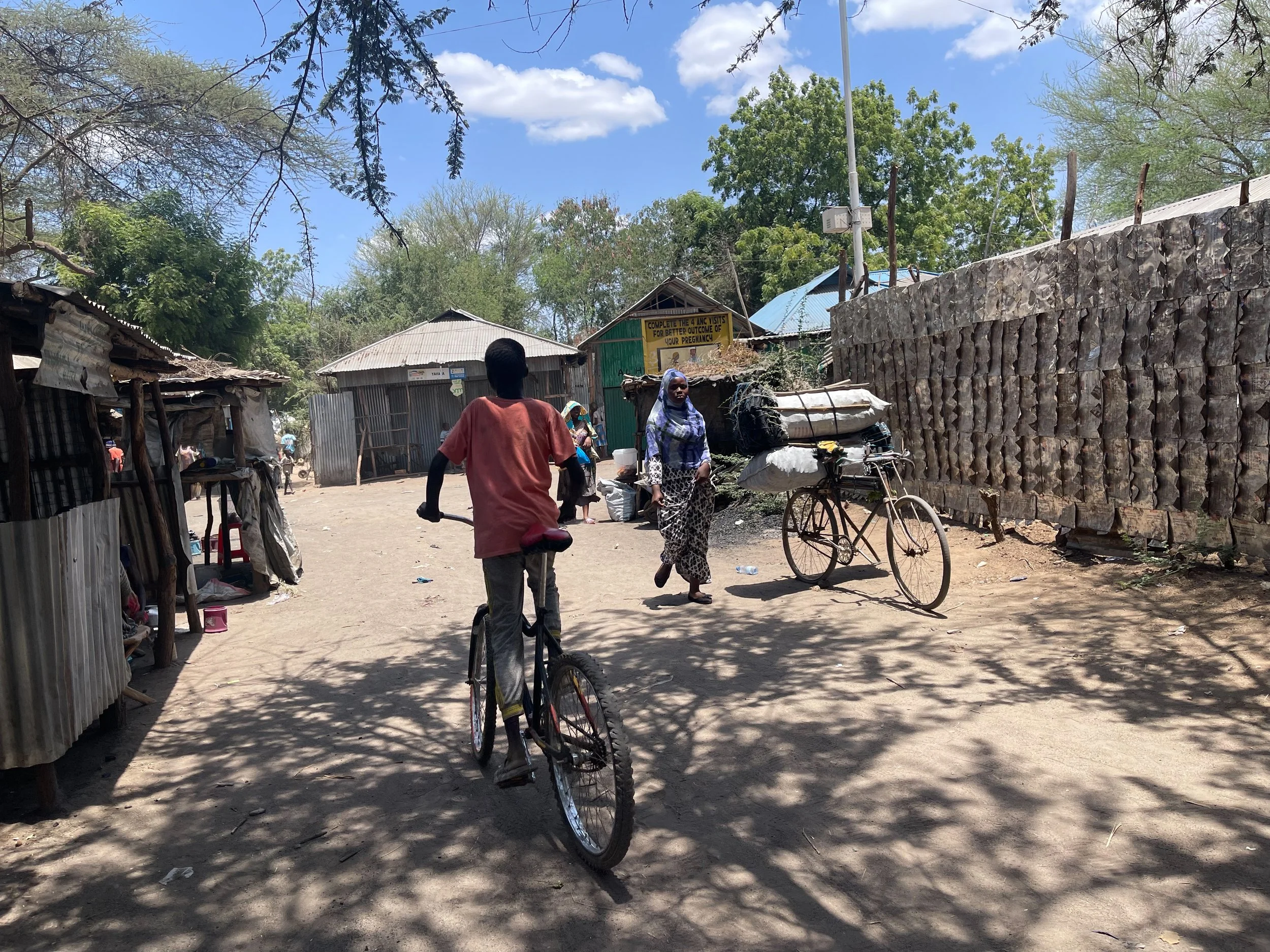If Only They Could Fly
September 13, 2023 • Written by Julie Winokur
22,694 feet above Kenya
I am returning home from the Kakuma Refugee Camp where I taught a four-day workshop in visual storytelling for 23 young refugees. They all aspire to come to the United States for college. Their dreams are infinite, their hopes huge, their chances are slim.
While I experience the literal heights of mobility, my students are confined to an arid, desolate corner of northwest Kenya without paved roads or running water. About 5% of them have access to electricity. According to UNICEF, kakuma is the Swahili word for “nowhere,” although when I consult several other translations, it means “suck it up.”
Ethiopian, Somali, South Sudanese, and Burundian, the young people in the camp have been there for most, if not all, of their lives. Kakuma was established over 30 years ago, and has become home to more than 200,000 people who are not allowed to leave its boundaries and who cannot earn official salaries over $200 per month. But survival breeds ingenuity – 2500 small businesses have sprung up, and life goes on inside the camp. Miles of rutted dirt roads are lined with makeshift homes, shops, restaurants, mechanics, churches, mosques…all the basic necessities of life.
Permanent housing is being built in the Kalobeyei Integrated Settlement area of Kakuma Refugee Camp. Photo by Julie Winokur
I traveled to Kenya with three colleagues from Rutgers University in New Jersey who are trying to establish an educational pipeline for refugees. They are part of a growing number of faculty and administrators who recognize higher education as THE solution for breaking the cycle of statelessness. Tim Raphael, my co-founder of Newest Americans who runs the Rutgers-Newark Center for Migration and the Global City, is leading this initiative despite profound bureaucratic and financial obstacles.
We arrived on a Wednesday morning at the small compound of Elimisha Kakuma, a college preparatory program founded by three former residents of the camp who managed to go to universities in the U.S. (Several months ago, Tim and I met Dudi Miabok, one of the founders of Elimisha, at a conference hosted by Princeton University. We were so impressed that we knew we had to come to Kakuma.) Additional students came through the Open Society University Network’s Hub for Connected Learning (OSUN), which has a robust program in Kenya geared toward college prep.
At the headquarters of Elimisha Kakuma, 23 students immerse in visual storytelling. Photo by Julie Winokur
(L-R) Tim Raphael, Newest Americans Co-founder; Michael Conteh, PhD candidate at Rutgers-Newark; Julie Winokur, Talking Eyes Media; Paul O’Keefe, Geography Professor at Rutgers-Newark; Mike Onyango, Open Society University Network.
Despite being established over 30 years ago, there are still no paved roads inside the camp. Photo by Christian Baobab
Photo by Maybior William Deng
40,004 feet above the Atlantic
It’s one thing to imagine the merits of helping the most disenfranchised people in the world. It’s another to meet a remarkably motivated group of young people who could thrive anywhere, like plants that grow between the cracks in pavement. They are not limited by their ability, but by the external obstacles of the asylum application process, college admission process and a nonnegotiable need for scholarships. It is hard to imagine my own children navigating this gauntlet successfully.
Despite the extreme heat, and the lack of reliable internet or proper cameras, my students overcame multiple barriers to participate in the workshop. Arriving by boda boda (motorbikes), sometimes traveling more than half-an-hour, they spent the first two hours of each day in a 90-degree darkened room discussing the nuances of visual language and learning the basics of composition, light, shadow, pattern and symmetry. I don’t remember ever teaching a more eager, receptive, diligent group of young people, who despite the raging heat remained alert and engaged throughout.
On the second day of our workshop, one of my colleagues from Rutgers, Michael Conteh, 47, had to defend his doctoral dissertation via zoom from Kakuma. Conteh is an animated, robust presence who fled Sierra Leone as a teenager and was taken in by an aunt in Namibia. He subsequently earned three masters degrees—one in Holland and two in the U.S.—and was now at the finish line of completing the highest degree in the world. The symmetry of living as a refugee and then returning to a camp like Kakuma to mark his highest achievement was poetically gratifying for all of us. Conteh was living proof to the students that tenacity can pay off despite a world that seems determined to keep them down.
During the afternoons, the students used their cellphones to explore their familiar world through fresh eyes, attempting to portray the reality of life in the camp. Their photographs depict young girls transporting water in the morning, boys pulling bicycles stacked with charcoal, soccer matches, children on slides, Turkana women with beaded necklaces that seem to prop up their heads, goats, chickens, motorcycle repair shops, a dry lake bed, ditches and vast miles of desert scrub. Through humanity and adversity, the camp teems with life in these images. Even the paved road at the edge of the camp has an aura of magic beneath bright street lights at night.
Photo by Josephine Cornelius
Photo by Nyandeng Arop Ater
As outsiders, we are quick to identify the poverty and suffering that greets the eye. Photography has made a sport out of rendering refugees as their most tragic selves. The subtleties of spirit that compel people forward each day in Kakuma are much more difficult to visualize, and my students were uniquely qualified guides. They are intimately aware of the forces that keep Kakuma moving and their pictures show a level of comfort in the chaos they know. One girl told me a friend had managed to go to Canada for school. After she arrived, she broke down in tears when she realized she was alone in the world far away from the camp. Life outside is not paradise, despite its running water and air conditioning, and the students who do manage to extricate themselves face new challenges as outsiders in a competitive, isolated world.
Photo by Tamanji Logodi
Photo by Ajier Bior
Photo by Atong Tou
Descending into Newark
The distance between my world and the students’ spans the chasm between mobility and confinement, opportunity and suppression. Like refugee camps around the world, Kakuma started as temporary emergency housing, and has since grown into a permanent, multigenerational sprawl where babies are born into relative captivity. No country claims these souls, so they are resigned to a state of indefinite limbo. Without mobility or opportunities to work, they are trapped in a form of stasis.
Perversely, we are willing to spend billions of dollars in humanitarian aid that keeps people dependent, rather than investing in their potential to build new lives for themselves.
It is impossible to believe that in the 21st century, we would accept this plight for over 35 million refugees worldwide. Efforts like Elimisha Kakuma help educate the younger generation so they can become fully participating members of society, which has a magnifying effect on entire families and communities. For more selfish reasons, with a birth deficit in the West, why would we squander this precious resource?
During the workshop, the students’ visual literacy grew more acute. Within two days they were using the language of leading lines and the Rule of Thirds, identifying light sources and perspective in each other’s photographs. By their final show, they were eager to share their personal visions of life in the camp. While I was not providing them with survival skills or a concrete opportunity for college admission, I had come to share some tools that would improve their communication while enhancing their appreciation for the world around them. It was the best self-sustaining resource I could guarantee them in a world that is unfairly stacked. I hope that they build on their power of story to open doors, prove their potential and show the world the truth of their situation.
In the meantime, I urge anyone reading this to help support the efforts of Elimisha Kakuma and OSUN’s Hub for Connected Learning.













